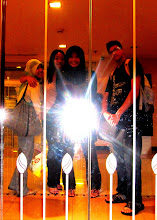
Tn.Haji Mazlan b.Ibrahim asked us to read this book to understand the whole process about planning and construction department.
Next department is Planning and Construction department under Tn.Haji Mazlan b.Ibrahim. We have been placed in the office at the head quarters.
Tn.Haji Mazlan b.Ibrahim is a very busy man and he always working outside and we can't follow him because he might back late.But he give us a very useful book to study..:)
PLANNING department need to do the estimation.
Estimation involves working out the cost of following:
a) Land
b) Salaries
c) Materials
d) Contract
e) Transportation
f) Overhead
Planning involves few steps:
1.Acquiring site plan
Site plan are essential for planning as well as for MWCS or CWA form
For minor works, sketching is enough
For major project, plan is compulsory with scale
2.Making a site visit
From site visit, estimator can obtained things that need for the project such as sources of supply, types of load used and site information especially the actual situation consists of trees, type of land and telephone lines.
3.Spot the pole position
Maximum spun length
The clearance that have been standardize by TNB
4.Determine the size of conductor
Initial load and load in future
Current carrying capacity
Voltage drop – the standardize voltage range from 216V to 252V for neutral to phase and 373V to 433V for phase to phase voltage.
The voltage drop given by formula:
% volt drop = √3 I(R cos Ө + X sin Ө)
Line voltage
Where; I = line current
R = line resistance
X = line reactance
5.Positioning stay
Position of stay can be determined due to position of spun
6.Positioning section fuse
Set up to avoid probability of overload and as protection
Installation due to operation and possibility feedback
ESTIMATING MATERIAL
After planning the whole low voltage overhead line system, the materials required can be easily to determine. For minor work, the materials is tabulated at the back of MWCS and in case of major projects, the listing of material is tabulated in schedule E.
ESTIMATING SALARIES
First step involved is to determined the days that the workers should finish their work. For the example the low voltage unit can erect 2 spun in a day, therefore to erect 10 spun need 5 days. The salaries of the people who are involved such as labor, technician, foreman, technical assistance and engineer will be estimated due to days required and the salary is tabulated in schedule D.
ESTIMATING TRANSPORTATION
The cost of transportation is estimated due to distance from yard to site of project. It is also depend to the number of strips throughout the entire project. It is tabulate in schedule G.
ESTIMATING CONTRACT WORK
Estimates for contract work are tabulated in schedule F.
We get this information from the book which we find very useful and help us a lot to complete our report. We grab the opportunity to complete our log book, report and video while we working in the office. Luckily our officemates is very kind and help us a lot!




























